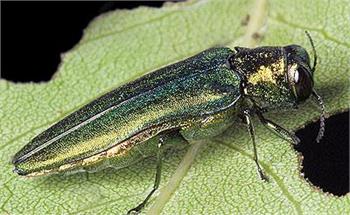 |
Emerald Ash Borer
 |
What does an emerald ash borer look like?
The adult emerald ash borer is metallic green in color, with an iridescent purple abdomen hidden beneath the forewings. It has an elongated body and is 3/8 to 1/2 inch long and is about 1/16 of an inch wide. You may see adults from June to August, when they fly in search of mates.
The emerald ash borer larvae is about 1 1/2 inches at maturity. It is creamy white in color and has a tiny, brown head. The eggs are white at first, but turn deep red as they develop.
What is the reproduction cycle of the emerald ash borer?
May to August: Eggs hatch into larvae and tunnel into ash trees.
August to October: Larvae feed under tree bark
October to May: Larvae over winter under tree bark
May to June: Adults emerge leaving D-shaped exit holes
Mid-May to Mid-August: Adults mate then lay eggs in ash bark
Can the emerald ash borer invade my home/business?
Emeral ash borers will rarely invade homes or structural properties.
The beetle’s immature or larval form spends its life feeding beneath the bark of ash trees. As a result, the ash tree host suffers extensive damage to its vascular system, depriving the tree’s crown of water and nutrients. Research conducted by Michigan State University and the USDA Forest Service has shown the emerald ash borer attacks both stressed and healthy ash trees, typically killing its host in three to five years. All ash species in Wisconsin are at risk of attack, including white, green black and blue ash.
What are the symptoms of an emerald ash borer infestation?
Symptoms of emerald ash borers don't become obvious until two or more years after borers enter a tree. Trees begin to show dead branches throughout the canopy, beginning at the top. Foliage in the top of the tree is thin and discolored. Sprouting at the base and/or on the main stem of the tree, often just below where the larvae are feeding. Woodpeckers feed on emerald ash borer larvae located under the bark. Feeding is typically evident higher in the tree where the emerald ash borer prefers to initially infest. Vertical splits in the bark are caused due to callus tissue that develops around larval galleries. Larval galleries can often be seen beneath splits.
What are the signs of an emerald ash borer infestation?
As larvae feed under the bark they wind back and forth, thus creating S-shaped larval galleries that are packed with frass and sawdust and follow a serpentine pattern. The larvae are cream-colored, dorso-ventrally flattened and have pincher-like appendages (urogomphi) at the end of their abdomen. Mature larvae reach 1 1/2 inches in length and all larvae are found feeding beneath the bark.Then, as adults emerge from under the bark they create an emergence hole ~ 1/8 inch in diameter and D-shaped.
http://www.batzner.com
2191 page views
|
|
|
|